Mar 9, 2021
Boat Lift Common Mistakes
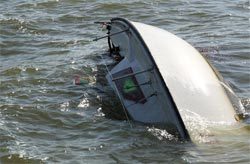
My boat lift cable broke…and I can’t get
No one wants to see this.
Imagine losing your boat even before getting it out on the water. Embarrassing – to say the least.
To keep you and your boat safe, Pier & Waterfront Solutions has some tips to avoid boat lift mistakes.
Failure to follow the manufacturer’s instructions means you’re more liking looking at a boat – IN the water, instead of – ON the water.
Never Exceed the Weight Capacity
It seems obvious, yet this happens every year. Extensive testing goes into ensuring a lift can support a calculated weight. Never ignore the results of those tests.
Engineers use a balanced load to determine the lift capacity of each unit. BOTH the weight and the load distribution are equally important to the safety of your boat lift.
Never assume a lift can support “a few extra pounds.” If the salesperson tries to sell you a lift rated for even a pound less than your boat and accessories weight, – find a different seller.
At PWS, we have the proper lift for all types of watercraft.
Give yourself plenty of wiggle room. Assume your boat weighs a couple of hundred pounds more than what even the manufacturer indicates. Then, add the extras. More on this later.
Why? It is not unusual to find several different weights listed for the same boat. Are you willing to chance the lowest listing?
The listed weight refers to the maximum weight of the craft plus all the extras.
Boaters also need to account for fuel, equipment, and anything else that will add weight to the boat.
Equally important – Properly Position the Boat.
Like a canoe in the water, balance is essential.
With a lift rating, manufacturers assume that you will balance the beams’ load when you put the boat on the lift. Only you have control over this.
On a boat lift, the boat should be equally balanced on the front and back beams. The left and right sides also should be centered. If the boat is balanced correctly, you should not be able to raise the bow at all with your hands.
A boat set too far back on the lift beams creates a light front. It’s much like the imbalance of a 100 -pound kid on one end of a seesaw with a 30 -pound kid on the other end. Waves can easily wash up beneath the front and work the boat off the lift.
At the same time, too much weight on one beam also creates extra strain on the cables. If the cables aren’t in perfect shape, they could break.
Something to consider
There are cables in each of the four corners holding your boat up. These cables distribute the weight of the boat equally to the four corners. That statement assumes you distribute the boat’s weight evenly on the rack beams in all four directions.
Assume you would like the boat sitting closer to the dock to make it easier to enter your boat. If you move the boat closer to the side of the lift frames (off-center), you are putting extra weight on the cables closest to you.
Now, put the boat a foot back on the beams.
You have not only put more weight on the two cables nearest the dock, but you have also added more weight to one cable at the “entrance” or back of the boat.
Now, add in a weakened cable, and you can see what’s coming next. Don’t let this happen to you. (Need a reminder- Look at the first image)
Load your equipment carefully.
Although you should load the boat after it’s in the water if you choose to load it before lowering the boat, distribute the load evenly.
Be Aware of Lifting Height
Please do not continue to raise the boat once it reaches the top. It seems simple enough. But wait, there’s a storm coming, and I have 1/2″ clearance between the rack and the top beam. Isn’t it best to close that gap?
Continuing to crank the winch places stress on all the parts, including the beams and possibly damaged cables. Here’s what could happen – see above.
We see this situation all the time.
Raising the boat too far may cause damage to any one of the lifting components. Some lifts automatically shut off when the lift reaches its maximum height (Hydraulic). Make sure this mechanism works as part of the lift’s routine maintenance.
Proper Loading
It may seem straightforward to load a boat while it is not rocking on the waves. However, anything loaded before lowering the boat into the water brings you closer to the lift’s maximum rating.
Loading the boat on the water helps you determine where the best weight distribution to maintain watercraft balance is.
We recommend that you lower the vessel before adding any heavy equipment or other essentials.
If your lift isn’t functioning correctly, it may be time to get a new ShoreMaster boat lift.
PWS will be happy to help you decide which lift is best for your location and type of watercraft. By talking to PWS, you can avoid making costly lift mistakes.
Want more information on this topic? Follow this link. Easier still – give the boat information to PWS. Let us do the calculations for you.
Where is Pier & Waterfront Solutions?
Pier & Waterfront Solutions, 7325 St. Hwy 57, is located 3 miles south of Sturgeon Bay. Go 1 mile PAST the intersection with County road MM (heading north). Look on the right at the next intersection – Idlewild Road and Hwy 57.
ARE WE OPEN?
Pier & Waterfront Solutions remains “open” year-round.
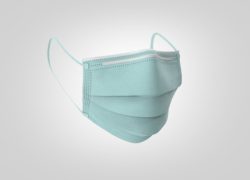
Please use face masks.
The virus continues to spread. PWS is conducting as much business as possible by email, text, or phone.
Site visits continue as usual. When making in-person contacts, we follow “social distancing” guidelines whenever possible.
Our display yard is OPEN 24-7
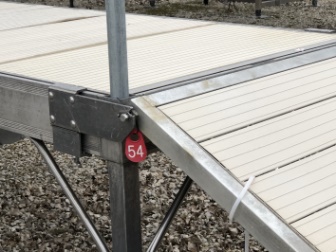
Red Tag
PWS‘s display area is always open for you to examine at your leisure. All displays available for sale have a numbered, red tag on them. Want more information on something you saw in our yard? Please reference that number when you inquire.
PWS will provide estimates by email to make the process faster, safer, and paperless.
Call, message, or email us with any questions.
Thank you for allowing us to work with you.
Feb 23, 2021
Ramps vs. Gangways
A frequently asked question is – what is the difference between ramps vs. gangways?
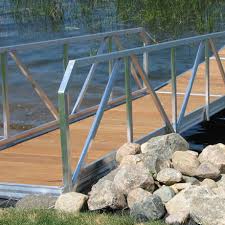
Gangways
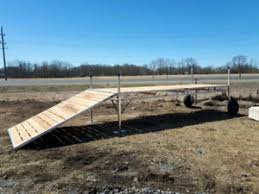
Standard dock ramps
When choosing between ramps vs. gangways, first, think about what your neighbors are using. Remember, your dock will most likely sit at the same height!
Would you, your family, or guests be comfortable going up that incline to use the dock?
Do they need a running start to get up to the dock? If they do, a ramp is not the way to go.
Ramps work great for a level or short distance up or down. They don’t need handrails due to their length, and the angle to the dock is not steep.
How high is your dock above the water?
On an inland lake, you usually are about 1 foot above the water at the most. Since the waves seldom get more than a foot high on a lake, you don’t have a steep climb to get to the dock. A simple ramp will do an excellent job for you.
One more thing to consider about a ramp
Please don’t allow yourself to be talked into using a ramps narrower than the dock itself. It’s an accident waiting to happen.
Someone walking to shore may get distracted and step off the dock expecting the ramp to be the same width. Foolish but true.
Ramps or gangways should always match the width of the dock. You don’t want someone stepping off the edge when they thought the dock was wider.
Consider your shoreline
What do you have to walk over to get to your dock? Is it a sandy beach or a rocky shore with stones the size of the palm of your hand? Are there large boulders that only the kids enjoy climbing?
Is rip-rap only is the first obstacle followed by the rocks?
Now, with the rip-rap, you may experience a difficult time getting over the rocks. In some cases, the water is right up to the rip-rap.
Once over the rip-rap, you may have to walk over some rough terrain to get to the dock or pier.
Gangways are a safe and straightforward solution to your problem.
Consider both the length and width you need. For example, the PWS 3-Season Pier offers various pier and ramp widths and lengths to fit your needs.
PWS offers ramps and gangways with the same decking as the rest of your dock. It all fits together seamlessly.
Do you have rip-rap?
Due to the high water, you may have installed rip-rap along the shoreline to protect property values.
Now, with the large rip rap, you may have a difficult time getting over the rocks.
You may also have to walk over some rough terrain to get to a dock or pier.
What’s the solution?
To start with, PWS can add stairs in the form of flat rocks or steel steps right in the rip-rap. From there, we have gangways in 20 ft. lengths to finish your walk over any obstructions.
Have an aluminum dock?
PWS has 16′, 20′, and 24′ lengths with handrails included. These significantly reduce the chance of a twisted ankle or a broken leg or arm.
No rip-rap?
The high water likely means your dock is higher than previous years to escape the waves’ power in a storm.
Now you need ramps or gangways to access the dock. A ramp, which is usually 8-10′ long, will give you a steep angle to climb under some circumstances.
The best way to access your dock when it is this high is via gangways. The longer gangways provide a gradual slope that young and old will appreciate.
A gentle transition from the shoreline to your dock is essential for a seamless, gentle climb. (As a side note, the long gangways mean you usually need fewer sections of the pier.)
PWS offers stairs, ramps, and gangways to access your dock.
One of the critical choices you’ll make is choosing between ramps and gangways.
What do you have to walk over to get to your dock?
What do you have to walk over to get to your dock – Sand, rocks, or boulders?
As you think about the length, make sure you keep in mind the ramp’s width. PWS has various options to suit your needs.
Ramps
If you don’t have far to walk (less than eight feet from shore to dock), a ramp is an excellent choice. That is unless the pier is set high.
Ramps are standard on shorelines where the water level doesn’t fluctuate much. The ramp is usually short enough that they don’t require handrails. However, longer approaches provide a gentle slope to a higher dock.
Aluminum Ramps come in 4′ x 4′, 4′ x 8′, and 6′ x 8′ sizes. The strength of aluminum does not normally allow for longer lengths without handrails.
PWS will advise you which type of dock access works best in your situation.
Gangways
If the distance from your dock to the shore is:
1. Long and you have to walk over large rocks or boulders:
2. The dock is set high: or
3. You get a lot of debris floating along your shoreline – Consider gangways rather than ramps.
Unlike ramps, gangways provide a gentle slope to walk up because of the distance they cover.
A 20′ gangway could reduce the cost of your dock system too.
Aluminum Gangways
Aluminum residential gangways are 4′ wide and come in lengths of 16′, 20′, and 24′.
An alternative for galvanized docks would be a steel gangway, which comes in 20′ lengths. As you can imagine, this longer length is much more comfortable with less incline.
Let’s summarize these ideas.
Let PWS find the Perfect Dock System for you.
Determining what a good fit would be is an integral part of making your dock system perfect.
PWS offers high-quality and affordable options for gangways, ramps, and accessories. We provide the expertise and expert knowledge you need to determine which option will work best for your situation.
PWS can help you plan the perfect boat docking system for your area.
Get started HERE!
Where is Pier & Waterfront Solutions?
Pier & Waterfront Solutions, 7325 St. Hwy 57, is located 3 miles south of Sturgeon Bay. It’s 1 mile PAST the intersection with County road MM (heading north). Look on the right at the intersection of Idlewild Road and Hwy 57.
ARE WE OPEN?
Pier & Waterfront Solutions remains “open” year-round.

Please use face masks
The virus continues to spread. PWS is conducting as much business as possible by email, text, or phone.
Site visits continue as usual. When making in-person contacts, we follow “social distancing” guidelines whenever possible.
Our display yard is OPEN 24-7
The PWS display area is always open for you to examine at your leisure. All displays available for sale have a numbered, red tag on them. Want more information on something you saw in our yard? Please reference that number when you inquire.

Red Tag
PWS will provide estimates by email to make the process faster, safer, and paperless.
Call, message, or email us with any questions.
Thank you for allowing us to work with you.
Feb 2, 2021
Top Signs You Need a New Dock
Time for a new Dock? Piers and docks that are more than ten years old may show some signs of wear or damage. Without proper maintenance, your dock system may not look or perform properly. Remember, it is possible to repair minor damage at a reasonable cost.
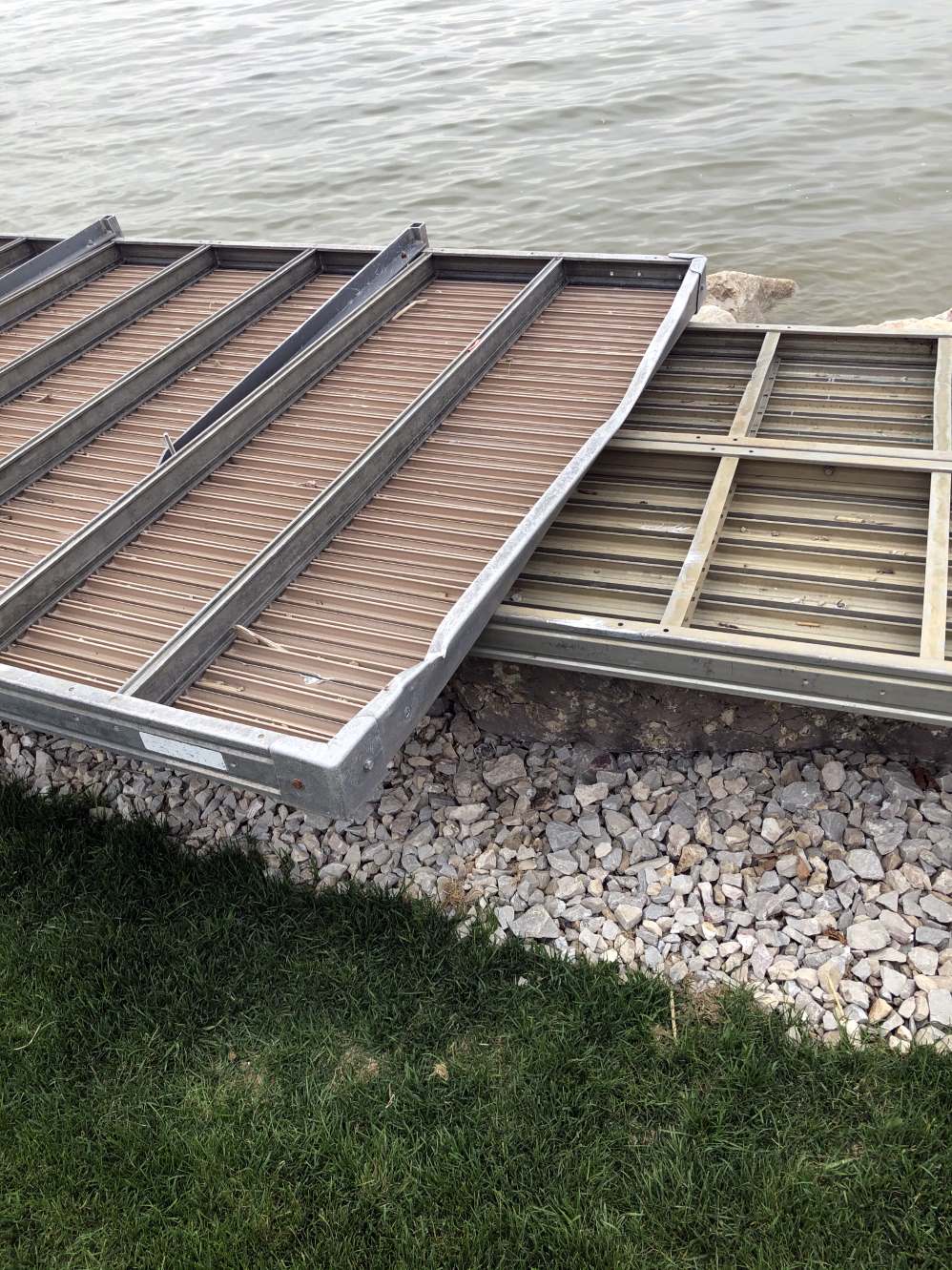
New Dock Needed
Be sure to contact Pier & Waterfront Solutions for an inspection if you have damage and you aren’t sure what repairs to make.
If your dock is getting dangerous, unsteady, replacement may be the only option.
Here are the five signs that you should think about when investing in a brand new pier.
Widespread Rust
Some metals exposed to water will rust. Small amounts of rust can be an easy fix. If possible, replace or repair an individual part before it gets out of control.
Larger rust areas could spread, which can lead to structural failure in the future. In cases like these, a completely new pier might be necessary.
Aluminum docks made of durable, rustproof metal are more resistant to rust than others. Aluminum is an option when considering upgrading or replacing a failing wood dock.
Wood Rot
Wooden docks can rot when the water has been allowed to seep in. Moss, mildew, algae, and other growth can trap moisture in a wood dock, worsening the problem. You can solve or prevent this problem by keeping your pier clean and well maintained.
If the damage involves minor areas, replace the components with new, treated lumber. But, when several locations are rotting, it’s time to replace your dock.
Consider replacing a wooden dock with different materials. Those materials include aluminum painted to look like wood. These are some of the premium ShoreMaster decking options.
Cracking or Warping Dock Supports
Certain support materials can become cracked or warped thanks to pressure from waves.
Accidents can also happen. If a boat or a large floating object hits the pier, cracks may appear on the legs or structural components. PWS can make the repairs.
But, stay safe, replace the entire structure when significant damage occurs. If the damage involves the legs or critical structural components, it may be time to replace the whole section or structure.
Tip: Prevent damage from boat collisions – install bumpers on the perimeter of your pier.
Damaged Foundation
Permanent docks sit on posts that support the pier. Assessing the damage below the waterline is difficult. Repairing it requires specialized equipment. PWS can help.
Pier foundations are subject to shifts causing severe damage. Any cracking is a sign that further investigation and possibly replacement is necessary.
Contact Pier & Waterfront Solutions for an inspection.
Can’t Secure the legs Properly?
Permanent dock systems have supports to hold them up. Supports are driven into the ground until it hits a stable area for stability. In some cases, depths reached can be as much as 100 feet.
A floating pier might be a good option if you do not encounter large waves. The advantage of a floating dock is that it compensates for changing water levels as they occur.
In some cases, a floating dock can remain in the water throughout the winter months IF there is no ice movement. The pier may be released from its shore anchor points in small harbors, moved into deeper water, and tied off. The pier is allowed to float with any minor ice movement, but it stays secured until spring.
Custom Boat Docking Systems by PWS.
If it’s time to replace or upgrade your boat docking system, PWS can help.
PWS has helped many shoreline owners find their perfect dock and boat lift solution.
Need a repair, a completely new pier or boat lift system, or the ideal accessory? PWS‘s customer support team can help.
Contact Pier & Waterfront Solutions for more information. We know what works best for your area.
Where is Pier & Waterfront Solutions?
PWS, 7325 St. Hwy 57, is 3 miles south of Sturgeon Bay and 1 mile PAST County road MM’s intersection (heading north). Look on the right at the intersection of Idlewild Road and Hwy 57.
ARE WE OPEN?
Pier & Waterfront Solutions remains “open” year-round.

Please use face masks
The virus continues to spread. PWS is conducting as much business as possible by email, text, or phone.
Site visits continue as usual. When making in-person contacts, we follow “social distancing” guidelines whenever possible.
Our display yard is OPEN 24-7

Red Tag
PWS‘s display area is always open for you to examine at your leisure. All displays available for sale have a numbered, red tag on them. Want more information on something you saw in our yard? Please reference that number when you inquire.
PWS provides estimates and quotes by email to make the process faster, safer, and paperless.
Call, message, or email us with any questions.
Thank you for allowing us to work with you safely.
Let’s all stay safe!
Jan 26, 2021
How to Get Rid of Algae on Your Dock
An Algae free dock or pier is vital for a beautiful waterfront, not to mention safer for you and your family. Piers are a great place to entertain your guests. Did you ever notice your guests soon find their way down to the pier? Your guests can’t resist the water.
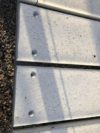
Typical Plank decking
Algae buildup on your boat lift, decking, and accessories is unattractive and slippery.
One of the biggest appeals of a dock or pier for many boaters is getting away from day-to-day life. We all want to enjoy and connect with nature.
That could be as simple as taking in the scenery, fishing, or watching wildlife.
It’s also the reason everyone must do what we can to keep the waterways healthy. That way, we can all enjoy nature’s beauty for years to come.
It’s essential to clean algae when you see it. It’s even more critical to prevent it from growing in the first place.
First, it’s essential to understand how mold and mildew form in the first place. To do that, we recommend that you follow this link:
https://wisconsinpws.com/cleaning-wood-decking/
Dealing with algae, mold, or mildew doesn’t mean investing in expensive solutions.
Removing moisture and the “food sources” mentioned in the article, go a long way to cut mold and mildew.
With these three tips, you can do it yourself.
Invest in the Right Dock
No dock will be immune to algae growth. Anything exposed to water will be affected by algae. But, aluminum boat lifts and docks can help cut algae growth. Aluminum is better at resisting algae growth than other materials like wood. Additionally, aluminum is easy to clean.
Choose Safe Products
When cleaning your dock and boat lift, use a non-corrosive cleaning solution. Cleaning can be as simple as using baking soda or a few drops of water-based dishwashing liquid. You already have these in your home.
The EPA’s Sager Choice Standard can help determine which products are best to use. Unfortunately, only a government bureaucrat can understand the standard without rolling their eyes. The government does not endorse products by name, so you have to make the judgment yourself.
Pick something:
Biodegradable:
Phosphate-free:
Having a neutral PH: and
Rub the surface of your dock and lift down
with a soft cleaning pad or brush.
When done, rinse with clear water or blast the dock surface with a pressure washer.
KNOW WHAT TO AVOID
Some cleaning products have environmental and health risks. Thus, it’s essential to watch what you put in the water. Ordinary household cleaners will increase nutrient pollution in lakes and streams. The result is algae blooms and oxygen depletion, which hurt the water and wildlife. In general, you should avoid any cleaning products that contain these hazardous ingredients:
-
-
-
-
-
-
- Antibacterials and disinfectants
-
-
-
-
-
-
- Butyl glycol, ethylene glycol, or monobutyl
-
-
-
-
-
-
- Phosphorous and phosphates
Major pollutant
Proper Fueling
Carefully refueling a boat keeps oil and gas out of the waterways. It’s illegal to discharge petroleum products into United States waters.
It’s against the law to use chemicals to disperse a spill. Dispersants cause the petroleum to sink to the bottom. It then permanently damages the bottom sediments.
Sewage Treatment
We know no one wants to think about sewage, but it’s an essential part of human and waterway health and safety.
It’s also illegal to discharge untreated wastewater on inland waters.
Use onshore facilities whenever you can. Dispose of human waste in:
1. Porta-potties:
2. Composting heads, or
3. An installed toilet with a required
marine sanitation device.
Waste Management
For all other waste, recycle what you can and properly dispose of what you can’t.
Recycling materials like plastics, paper, metal, and glass keep them out of landfills and off our beaches.
We now know that plastics in the water are a significant pollutant. Plastics are already affecting the waters of the Great Lakes.
Dispose of all waste materials properly. Make sure nothing goes overboard, including cigarette butts. Provide waste and recycling containers on your boat and piers.
Keep everything tied down when you’re moving on the water or the highway. Participating in a cleanup event accessible only by a boat can also be a rewarding day to protect the water.
Walking your shoreline and picking up these materials can help the environment.
Boat Maintenance and Cleaning
Prepare a comprehensive boat maintenance checklist. Changing engine oil and checking your fluid levels keep your boat running smoothly. This, in turn, makes it less likely to pollute.
Check for leaks from steering cables, drips from your oil changes, or fuel from leaky fittings. All these contaminants can find their way into the bilge.
Change engine oil and other fluids carefully. Dispose of used filters, oil, absorbent pads, and rags properly.
Keep your boat clean, and avoid soaps and harsh cleaners. Save heavy-duty pressure washing for designated wash-down areas at boat launches.
Yes, keeping the environment clean involves some work.
Your property is expensive because it’s on the water. Why let waste products deteriorate the value of your property. A little work goes a long way toward keeping the water beautiful for future generations.
ShoreMaster and PWS have been here for years, and we plan on being here for many more. We want you to enjoy everything nature has to offer. Let’s all work towards the same goal – a clean environment.
Where is Pier & Waterfront Solutions?
PWS, 7325 St. Hwy 57, is 3 miles south of Sturgeon Bay and 1 mile PAST, County road MM’s intersection (heading north). Look on the right at the intersection of Idlewild Road and Hwy 57.
ARE WE OPEN?
Pier & Waterfront Solutions remains “open” year-round.

Please use face masks
The virus continues to spread. PWS is conducting as much business as possible by email, text, or phone.
Site visits continue as usual. When making in-person contacts, we follow “social distancing” guidelines whenever possible.
Our display yard is OPEN 24-7

Red Tag
PWS‘s display area is always open for you to examine at your leisure. All displays available for sale have a numbered, red tag on them. Want more information on something you saw in our yard? Please reference that number when you inquire.
PWS provides estimates and quotes by email to make the process faster, safer, and paperless.
Call, message, or email us with any questions.
Thank you for allowing us to work with you safely.
Let’s all stay safe!
Dec 8, 2020
Does High Water require the 3-Season Pier?
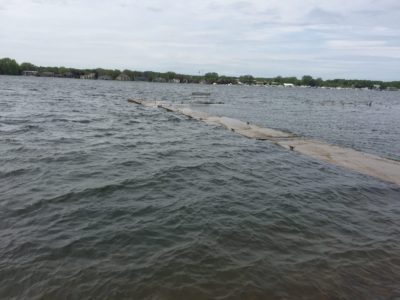
High water over the dock
High water continued again in 2020 and many people looked for a stronger, more durable pier for 2021.
After 2 years of design improvements, the 3-Season Pier was introduced in 2020. It was a hit and sold out quickly.
Looking for a new pier?
In the early part of the 2020 boating season, the number of washed-out docks increased substantially. Storms raged throughout the boating season.
There are many brands of docks on the “Bay”. Every brand was represented in the list of docks & piers damaged or destroyed this year. That is, except the 3-season pier. It also withstood the Lake Michigan turbulent waters.
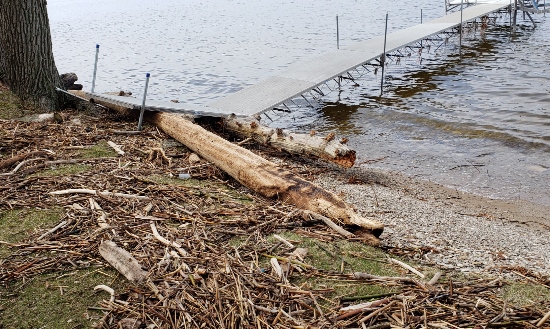
High water and debris
During 2020, many people saw floating debris during and after the storms. The debris moved along the shoreline. In some cases, uprooted trees and logs were responsible for taking out docks and lifts. The debris continued to move long distances before it finally settled on the shore again.
Now, we don’t represent that a 3-Season Pier will completely stop damage like that. But there is a much better chance of a 1/4 ton pier (per section) with 2″ galvanized steel legs (2-3/8″ O.D.) withstanding the force of the waves. Compare that to the 1-1/2″ leg (1-7/8″ O.D.) used on lesser, lighter docks.
Why did high water prompt a new design?
Over the years, PWS realized that having strong steel legs was not enough for the current situation. We watched helplessly as the waves lifted the dock sections. When the dock section came down, they seldom came down evenly or level.
As waves battered the bottom of the pier, it twisted the dock frames and caused the legs to bend sideways as the dock comes down.
Once the legs bent, the entire structure was subject to rolling over. There had to be a way to reduce the pressure on the docks.
We quickly realized that solid decking was our worst enemy. With solid decking bolted to the frames, the full force of the waves had to be absorbed by the dock.
After research, we found that a deck that allows the water to flow through the decking was the best possible answer. We quickly introduced the ShoreMaster Glacier™ flow-through, open decking on our aluminum piers.
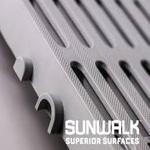
Sunwalk Decking
High water requires Sunwalk Decking™
When the galvanized steel, 3-Season Pier, was introduced, it included Sunwalk™ decking. After securing the decking to the frames with stainless steel screws, the 45% open area allowed most of the energy of the water to flow through the deck harmlessly.
Combining the 1/4 ton weight per 20′ section with a 45% open decking, and you have a winning combination.
Higher Water needed Longer Ramps too!
However, we did not stop there. We also realized that the piers had to be set high to reduce the number of times the waves could hit the decking. This created a problem. The short ramps going to the pier were too steep for people to comfortably walk up.
We designed a 20′ long ramp, thus making a gentle approach to the pier. The shore end includes built-in leg pockets to raise the ramp off the beach. These added legs allow any waves that get to the end to pass harmlessly under the frames.
When should I start looking for a new pier?
Now is an excellent time to research the features of the 3-Season pier and place a preseason order. It’ll be ready when you are in Spring. Don’t forget, we can take trades, too.
The exclusive 3-Season Pier is available only at Pier & Waterfront Solutions.
Conclusion
PWS has the best solution for your 2021 dock.
Call Jerry at Pier & Waterfront Solutions (920-493-4404) for more information.
Where is Pier & Waterfront Solutions?
Located at 7325 St. Hwy 57, it’s 3 miles south of Sturgeon Bay and 1 mile past the intersection of Cty MM (heading north). Look on the right at the intersection of Idlewild Road and Hwy 57.
ARE WE OPEN?
Pier & Waterfront Solutions remains “open.”
We have implemented measures to ensure the safety of our employees and visitors. At the same time, we are working to maintain the trusted service you expect.

Please use face masks
Because the virus has increased its spread, PWS is conducting as much business as possible by email, text, or phone.
Site visits continue as usual. When in-person contacts are necessary, we follow “social distancing” guidelines as closely as possible.
Display yard – OPEN
Our display yard is always open for you to examine at your leisure. All displays available for sale have a numbered, red tag on them. If you want more information or pricing, please reference that number when you call.
We provide estimates and quotes by email to make the process paperless, faster, and safer. Everyone should feel safe with these measures. Let’s get back to normal operations quickly.
What can YOU do?
Please conduct as much business as possible via emails, messaging, and phone. When you see our crews on-site, please practice “social distancing.”
Call, message, or email us with any questions.
Thank you for allowing us to work with you safely.
Let’s all stay safe!















